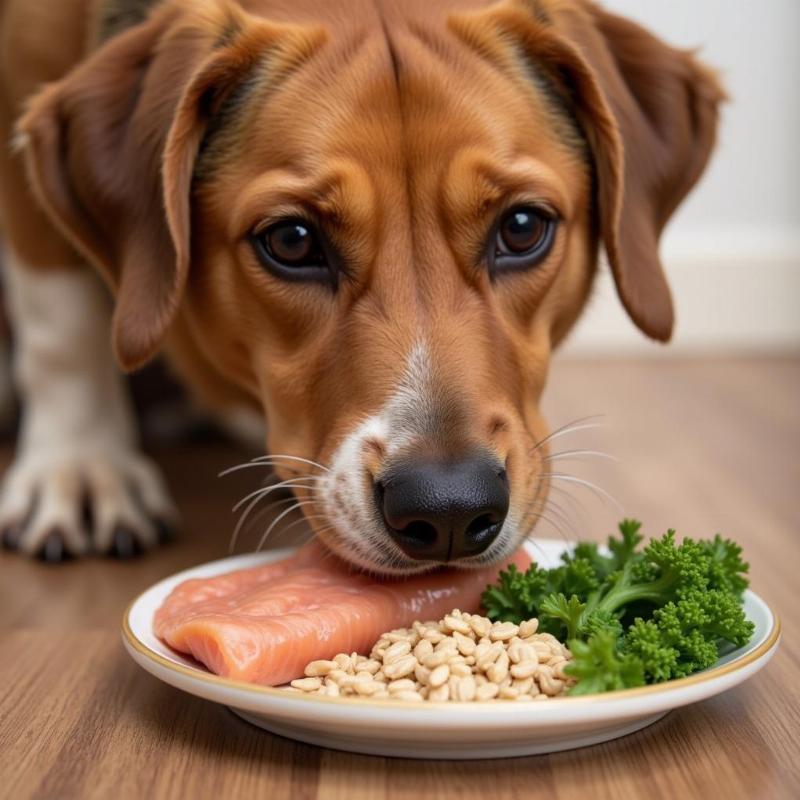A balanced diet is crucial for your dog’s overall well-being, just as it is for humans. The concept of yin and yang, originating from ancient Chinese philosophy, emphasizes the importance of balance and harmony in all aspects of life, including nutrition. Applying this philosophy to your dog’s food can help you create a diet that supports their physical and emotional health, promoting a long, happy, and vibrant life. “Yin and yang nutrition for dogs” focuses on providing a balanced blend of nutrients, tailored to your individual dog’s needs.
Understanding Yin and Yang in Dog Nutrition
The principles of yin and yang describe two opposing yet complementary forces. Yin represents cooling, calming, and moistening qualities, while yang embodies warming, energizing, and drying properties. In the context of dog food, this translates to balancing different types of ingredients and their energetic properties. For example, “yin” foods might include cooling vegetables like cucumber or kelp, while “yang” foods could be warming proteins like chicken or lamb. Finding the right balance for your dog depends on their breed, age, activity level, and any underlying health conditions.
Matching Your Dog’s Needs with Yin and Yang Principles
Different dogs have different dietary requirements. A highly active working dog, for example, will likely benefit from a more “yang” diet with higher protein and fat content to fuel their energy needs. Conversely, a senior dog with a calmer lifestyle might thrive on a more “yin” diet, rich in easily digestible proteins, fiber, and cooling ingredients. Consider your dog’s individual characteristics when tailoring their diet, and always consult with your veterinarian before making significant dietary changes.
Practical Tips for Balancing Your Dog’s Diet
Implementing yin and yang principles into your dog’s diet doesn’t have to be complicated. Here are some practical tips to get you started:
- Variety is key: Offer a diverse range of ingredients to ensure a broad spectrum of nutrients. Rotate protein sources, incorporate different vegetables, and consider adding small amounts of fruits.
- Seasonal adjustments: Just as our own dietary needs change with the seasons, so do our dogs’. In warmer months, incorporate more cooling “yin” foods, and in colder months, offer warming “yang” foods.
- Observe your dog: Pay attention to your dog’s energy levels, coat condition, and digestion. These are excellent indicators of whether their diet is balanced and meeting their needs.
 Dog Eating a Balanced Meal
Dog Eating a Balanced Meal
Common Misconceptions about Yin and Yang Dog Nutrition
One common misconception is that all “yin” foods are cold and all “yang” foods are hot. In reality, it’s more about the energetic properties of the food and its effect on the body. Another misconception is that a perfectly balanced diet must have equal parts yin and yang. The ideal balance varies depending on the individual dog. Consulting with a holistic veterinarian or canine nutritionist can provide personalized guidance.
The Benefits of a Balanced Diet for Your Dog
A balanced diet based on yin and yang principles can contribute to a healthier, happier life for your dog. Benefits may include improved digestion, increased energy levels, a shinier coat, stronger immunity, and better emotional balance. Dr. Emily Carter, a certified veterinary nutritionist, emphasizes, “By understanding the principles of yin and yang, we can create diets that truly nourish our dogs on a deeper level, supporting their overall well-being.”
Conclusion
Applying the principles of “yin and yang nutrition for dogs” can be a valuable approach to ensuring your furry friend receives a balanced and nourishing diet. By understanding the energetic properties of different ingredients and tailoring their diet to their individual needs, you can contribute significantly to their long-term health and happiness. Remember to consult with your veterinarian before making significant dietary changes.
FAQ
- What are some examples of “yin” foods for dogs? Cooling fruits and vegetables like watermelon, cucumber, and leafy greens.
- What are some examples of “yang” foods for dogs? Warming proteins like lamb, chicken, and root vegetables like sweet potatoes.
- How can I tell if my dog’s diet is balanced? Observe their energy levels, coat condition, digestion, and overall demeanor.
- Do I need to cook my dog’s food to apply yin and yang principles? Not necessarily. You can balance their diet with both raw and cooked ingredients.
- Where can I learn more about yin and yang nutrition for dogs? Consult with a holistic veterinarian or certified canine nutritionist.
Beautdogs.us: Your Trusted Source for Dog Care Information
Beautdogs.us is your premier online destination for comprehensive and engaging information on all aspects of dog care, breeds, and lifestyle. Whether you’re a new dog owner or a seasoned expert, we provide authoritative and accessible content to empower you with the knowledge you need to provide the best care for your beloved canine companion. We offer expert advice on everything from nutrition and training to grooming and health. Connect with us today for personalized support and access a wealth of resources to enhance your dog’s life! Email: [email protected], Phone: +1 501-555-7529.